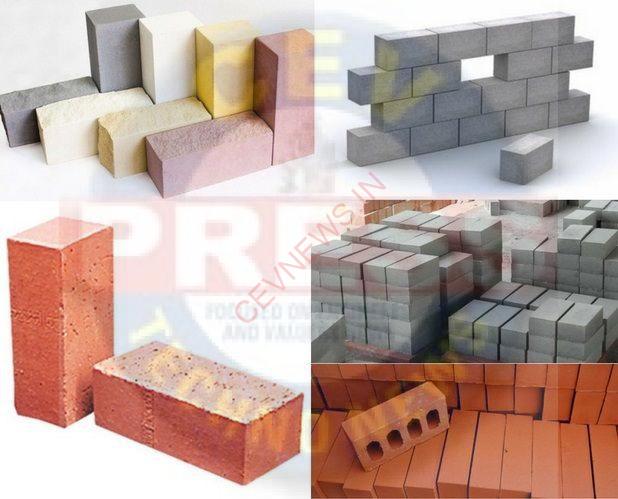DIFFERENT TYPES OF BRICKS USED IN CONSTRUCTION
Bricks are rectangular units of uniform dimensions. Clay is used to making bricks. In construction, there are different types of brick. When stone is not accessible, bricks are commonly utilized as a substitute. Brick is a common building material made of clay and comes in rectangular shapes. Because of their inexpensive cost and long lifespan, they have remained popular since ancient times.
Advantages of Bricks Used in Construction:
- Brick is fire-resistant and can sustain high temperatures.
- Brick is a long-lasting and sturdy material.
- .Individual brick problems can be solved without tearing down and rebuilding the entire structure.
- For environmental protection, brick does not require the use of paints
- Clay that is readily available aids in the production of bricks in the local area, reducing shipping expenses. It could suggest that brick construction is less expensive than stone, concrete, or steel construction.
Disadvantages of Bricks Used in Construction:
- Tensile strength is lower.
- Construction takes a long time.
- Because bricks absorb water quickly, there may be a shortage of airflow.
- Under significant seismic pressure, it has the potential to break.
- It isn’t easy to keep brick surfaces clean.
Different Types of Bricks Used In Construction
- Sun-dried bricks
Unburnt bricks or sundried bricks are the first and most basic example of bricks. The process of making these bricks lies in the name itself. Not burnt but dried in the sun for hardening, often used in rural areas or temporary constructions. They are not as strong, have reduced fire and water resistance, and hence is best when left to temporary structures in our list for types of bricks used on construction.
- Burnt clay bricks
The most widely used among the types of bricks used in construction, gaining it the name ‘common brick.’ Used in the construction of important structures such as columns, walls, and the foundation of the building. They come mainly of four types:
- First-class bricks (best quality bricks)
- Second class bricks (moderate quality)
- Third class bricks (poor quality)
- Fourth class bricks (over-burnt and in irregular shape)
- Jhama Bricks
Because it is burnt at a higher temperature and for a longer period than regular bricks, it is known as the vitrified brick. The shape is altered as a result. The absorption capacity is quite great. The strength is comparable to that of first-class bricks, if not greater. It’s used as a foundation’s lime concrete. It’s also a coarse aggregate in concrete slabs and beams that won’t be exposed to water.
- Concrete Bricks
Concrete bricks are made using solid concrete along with ingredients like cement, sand, coarse aggregates, and water. The sizes of these bricks can be tailored according to the size requirements. These are commonly used in facades, hidden/internal brickworks, fences, and tend to provide an outstanding aesthetic presence.
- Engineering Bricks
These have high compressive strength and are used for special applications where strength, acid resistance, low porosity, frost resistance is essential. Engineering bricks are most commonly used for basements, this is because in these areas chemical or water attacks are quite prevalent.
- Calcium Silicate Bricks
Calcium Silicate Bricks also commonly known as Sand lime bricks, these are made by mixing lime, sand, and fly ash. This type of bricks is used for numerous purposes in construction industries like masonry works, ornamental works in buildings, etc.
- Sand Lime Bricks
Made using a mixture of sand, lime, and possibly a color pigment to alter the final appearance of the brick, sand lime bricks have a high compressive strength, so they are a common option for load-bearing walls in houses and multi-storied buildings. This type of brick doesn’t require a high amount of mortar plaster, which saves time and reduces costs on a project.
Sand lime bricks are manufactured using both heat and pressure to accelerate the chemical reaction, resulting in bricks that have a smooth, uniform finish that’s ideal for construction projects. These bricks are also common as acoustic insulation because sound has a hard time passing through the dense sand lime material.
- Extruded Brick:
It’s manufactured by combining water and clay in a steel die with a fairly consistent shape and size, then wires to cut the resulting column into smaller units before firing. It’s commonly employed in construction projects with tight budgets. These bricks have three or four holes that account for up to 20% of the brick’s volume.
- Facing brick:
Facing brick is the material used outside any wall or structure. Facing bricks are uniform in size, stronger than other bricks, and have a longer lifespan. For a more attractive appearance, the color is red or brown colors. There are many face bricks available, each with its own set of techniques and technologies. Because facing bricks are typically used outside buildings, they should be weather resistant.
- Backing Brick
These bricks have no distinguishing characteristics or qualities. They are only used to support the wall behind the facing bricks.

